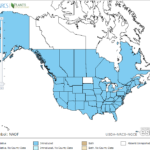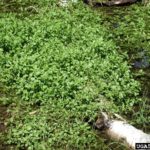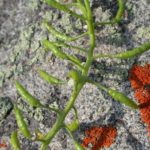Nasturtium officinale
Non-Native
- Mary Ellen (Mel) Harte, Bugwood.org
- Leslie J. Mehrhoff, University of Connecticut, Bugwood.org
- Mary Ellen (Mel) Harte, Bugwood.org
USDA, NRCS. 2018. The PLANTS Database (http://plants.usda.gov, 28 March 2018). National Plant Data Team, Greensboro, NC 27401-4901 USA.
Illustration: USDA-NRCS PLANTS Database / Britton, N.L., and A. Brown. 1913. An illustrated flora of the northern United States, Canada and the British Possessions. 3 vols. Charles Scribner’s Sons, New York. Vol. 2: 162.
What is Watercress?
Physical Characteristics
Leaves:
- Older leaves compound
- Young leaves simple
- 1.57- 1.72 inches long
- 3-11 leaflets
- Oval or sword shaped
Flowers:
- 4 white petals
- Above water
- Clustered on end of stems
- 0.12-0.2 inches long
Fruit:
- Thin
- Cylinder shaped
- Slightly curving
- 0.4-1.0 inches long
Seeds:
- About 0.04 inches long
- Round
- Found in seed pods
- Arranged in rows
Stem:
- Fleshy
- 3.9-23.62 inches long
- Easily breakable
Roots:
- Stringy
- Thin
- Rooting at nodes
Where Does it Grow?
Non-Native
Watercress can be found in streams and shallow water.
Is it Invasive?
Watercress is non-native to North America. It is an aggressive invader that out-competes the native vegetation for vital resources.
Pros and Cons of Watercress
Although, watercress is non-native, it is a food source for ducks, muskrats, and deer. Many people often use watercress as a peppery seasoning in their food.
This plant is not native to North America, but has naturalized in much of the United States. While it is not illegal to possess this plant in Texas, it should not be introduced into new water bodies and should be treated with herbicide when present.





